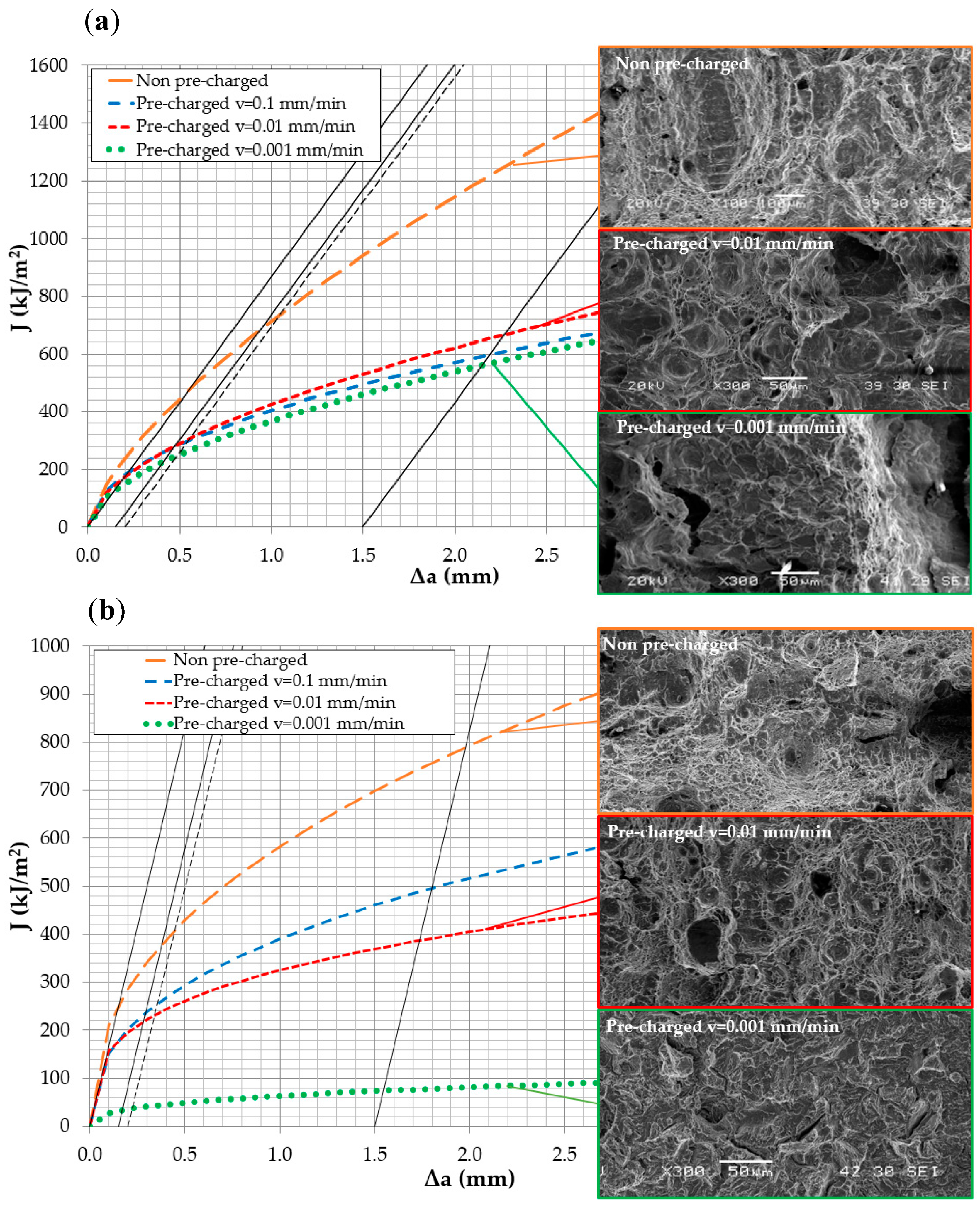Effect of the Strain Rate on the Fracture Behaviour of High Pressure Pre-Charged Samples †
Abstract
:1. Introduction
2. Materials and Methods
2.1. Materials
2.2. Fracture Toughness Tests
3. Results and Discussion
4. Conclusions
- Gaseous hydrogen pre-charge is a valid method to introduce hydrogen in the steels in order to study hydrogen embrittlement phenomena at room temperature.
- In general, hydrogen embrittlement increases as steel strength increases and as test displacement rate decreases, but this trend is dependent on the steel, on its microstructure and strength level.
Acknowledgments
References
- Dong, C.F.; Liu, Z.Y.; Li, X.G.; Cheng, Y.F. Effects of hydrogen-charging on the susceptibility of X100 pipeline steel to hydrogen-induced cracking. Int. J. Hydrog. Energy 2009, 34, 9879–9884. [Google Scholar] [CrossRef]
- Park, G.T.; Koh, S.U.; Jung, H.G.; Kim, K.Y. Effect of microstructure on the hydrogen trapping efficiency and hydrogen induced cracking of linepipe steel. Corros. Sci. 2008, 50, 1865–1871. [Google Scholar] [CrossRef]
- Sampath, D.; Akid, R.; Morana, R. Estimation of crack initiation stress and local fracture toughness of Ni-alloys 945X (UNS N09946) and 718 (UNS N07718) under hydrogen environment via fracture surface topography analysis. Eng. Fract. Mech. 2018, 191, 324–343. [Google Scholar] [CrossRef]
- Dincer, I.; Acar, C. Smart Energy Solutions with Hydrogen Options. Int. J. Hydrog. Energy. Available online: https://www.researchgate.net/publication/324392901_Smart_energy_solutions_with_hydrogen_options (accessed on 11 November 2018).
- Arafin, M.A.; Szpunar, J.A. Effect of bainitic microstructure on the susceptibility of pipeline steels to hydrogen induced cracking. Mater. Sci. Eng. A 2011, 528, 4927–4940. [Google Scholar] [CrossRef]
- Takeda, Y.; McMahon, C.J. Strain controlled vs stress controlled hydrogen induced fracture in a quenched and tempered steel. Metall. Trans. A 1981, 12, 1255–1266. [Google Scholar] [CrossRef]
- Zafra, A.; Peral, L.B.; Belzunce, J.; Rodríguez, C. Effect of hydrogen on the tensile properties of 42CrMo4 steel quenched and tempered at different temperatures. Int. J. Hydrog. Energy 2018, 43, 9068–9082. [Google Scholar] [CrossRef]


| Steels | E (MPa) | σy (MPa) | σu (MPa) |
|---|---|---|---|
| S355 | 210,000 | 386 | 542 |
| H8 | 226,000 | 792 | 857 |
| Displ. Rate (mm/min) | JIC (kJ/m2) | JICH (kJ/m2) | EI(%) | ||||
|---|---|---|---|---|---|---|---|
| 0.1 | 0.1 | 0.01 | 0.001 | 0.1 | 0.01 | 0.001 | |
| S355 | 750 | 297 | 306 | 247 | 60 | 59 | 67 |
| H8 | 450 | 260 | 230 | 40 | 42 | 49 | 91 |
Publisher’s Note: MDPI stays neutral with regard to jurisdictional claims in published maps and institutional affiliations. |
© 2018 by the authors. Licensee MDPI, Basel, Switzerland. This article is an open access article distributed under the terms and conditions of the Creative Commons Attribution (CC BY) license (https://creativecommons.org/licenses/by/4.0/).
Share and Cite
Díaz, G.Á.; Suárez, T.E.G.; González, C.R.; Varela, F.J.B. Effect of the Strain Rate on the Fracture Behaviour of High Pressure Pre-Charged Samples. Proceedings 2018, 2, 1417. https://doi.org/10.3390/proceedings2231417
Díaz GÁ, Suárez TEG, González CR, Varela FJB. Effect of the Strain Rate on the Fracture Behaviour of High Pressure Pre-Charged Samples. Proceedings. 2018; 2(23):1417. https://doi.org/10.3390/proceedings2231417
Chicago/Turabian StyleDíaz, Guillermo Álvarez, Tomás Eduardo García Suárez, Cristina. Rodríguez González, and Francisco Javier Belzunce Varela. 2018. "Effect of the Strain Rate on the Fracture Behaviour of High Pressure Pre-Charged Samples" Proceedings 2, no. 23: 1417. https://doi.org/10.3390/proceedings2231417




